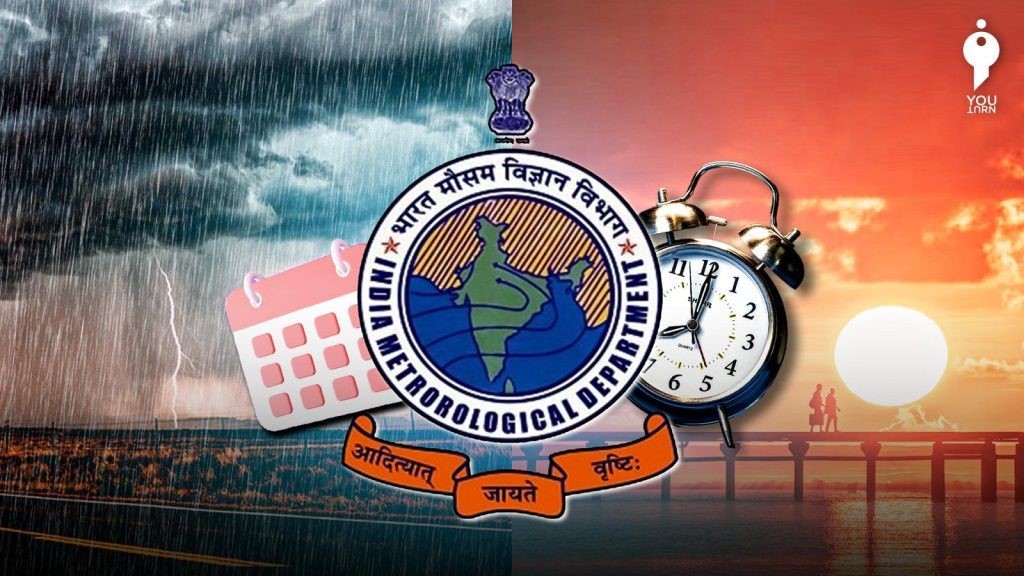Description

Disclaimer: Copyright infringement not intended.
Context
India celebrating 150 years of India Meteorological Department
Detail
HISTORY
- India is fortunate to have some of the oldest meteorological observatories of the world. The British East India Company established several such stations, for example, those at Calcutta in 1785 and Madras (now Chennai) in 1796 for studying the weather and climate of India. The Asiatic Society of Bengal founded in 1784 at Calcutta, and in 1804 at Bombay (now Mumbai), promoted scientific studies in meteorology in India.
- Captain Harry Piddington at Calcutta published 40 papers during 1835-1855 in the Journal of the Asiatic Society dealing with tropical storms and coined the word "cyclone", meaning the coil of a snake.
- In 1842 he published his monumental work on the "Laws of the Storms". In the first half of the 19th century, several observatories began functioning in India under the provincial governments.
- A disastrous tropical cyclone struck Calcutta in 1864 and this was followed by failures of the monsoon rains in 1866 and 1871.
- In the year 1875, the Government of India established the India Meteorological Department, bringing all meteorological work in the country under a central authority. Mr. H. F. Blanford was appointed Meteorological Reporter to the Government of India.
- The first Director General of Observatories was Sir John Eliot who was appointed in May 1889 at Calcutta headquarters. The headquarters of IMD were later shifted to Shimla, then to Poona (now Pune) and finally to New Delhi.
Mandates
- To take meteorological observations and to provide current and forecast meteorological information for optimum operation of weather-sensitive activities like agriculture, irrigation, shipping, aviation, offshore oil explorations, etc.
- To warn against severe weather phenomena like tropical cyclones, norwesters, duststorms, heavy rains and snow, cold and heat waves, etc., which cause destruction of life and property.
- To provide meteorological statistics required for agriculture, water resource management, industries, oil exploration and other nation-building activities.
- To conduct and promote research in meteorology and allied disciplines.
- IMD became the first organisation in India to have a message switching computer for supporting its global data exchange. One of the first few electronic computers introduced in the country was provided to IMD for scientific applications in meteorology.
- India was the first developing country in the world to have its own geostationary satellite, INSAT, for continuous weather monitoring of this part of the globe and particularly for cyclone warning.
.jpg)
Organisational structure
- At present IMD is under the Ministry of Earth Sciences (MoES).
- The Director General of Meteorology is the Head of the India Meteorological Department, with headquarters at New Delhi.
- There are 4 Additional Directors General at New Delhi and 1 at Pune. There are 20 Deputy Directors General of whom 10 are at New Delhi.
- For the convenience of administrative and technical control, there are 6 Regional Meteorological Centres, each under a Deputy Director General with headquarters at Mumbai, Chennai, New Delhi, Calcutta, Nagpur and Guwahati.
- Under the administrative control of Deputy Director General, there are different types of operational units such as Meteorological Centres at state capitals, Forecasting Offices, Agrometeorological Advisory Service Centres, Flood Meteorological Offices, Area Cyclone Warning Centres and Cyclone Warning Centres.
In addition, there are separate Divisions to deal with specialised subjects. They are: -
- Agricultural Meteorology
- Civil Aviation
- Climatology
- Hydrometeorology
- Instrumentation
- Meteorological Telecommunication
- Regional Specialised Meteorological Centre
- Positional Astronomy
- Satellite Meteorology
- Seismology
- Training
New projects/Schemes/Programmes approved/ initiated
- Integration of Landslide Susceptibility Module into Flash Flood Guidance System for better predictability of landslide associated flash floods in the vulnerable hilly regions of Indian Subcontinent.
- Integration of Urban Flood Module into Flash Flood Guidance System for real time flood monitoring of urban cities. In this context, Delhi has been selected for the pilot study on Urban Flood Modeling.
- “Drone based calibration activities of X Band Radar” installed at NIOT Chennai campus, Pallikaranai on 6th January, 2022
- Two Design storm studies for (i) Yammeng Hydro Project, Arunachal Pradesh and (ii) Katapati Barrage, Maharashtra got completed and the values sent to the concerned project authority
- National Monsoon Mission (NMM):Government of India launched NMM in 2012 with a vision to develop a state-of-the-art dynamical prediction system for monsoon rainfall on different time scales.
- Mausam App:Tool for dissemination of weather information and warnings in an attractive and user friendly manner.
- Doppler Weather Radars:Based on Doppler principle, the radar is designed to improve precision in long-range weather forecasting and surveillance using a parabolic dish antenna and a foam sandwich spherical radome.

Conclusion
- IMD has continuously ventured into new areas of application and service, and steadily built upon its infra-structure in its history of 150 years. It has simultaneously nurtured the growth of meteorology and atmospheric science in India. Today, meteorology in India is poised at the threshold of an exciting future.
|
PRACTICE QUESTIONS
Q. IMD's contribution to global safety and economic development through its role as Regional and Global Centres for weather and climate forecasting is commendable. Discuss (200)
|











